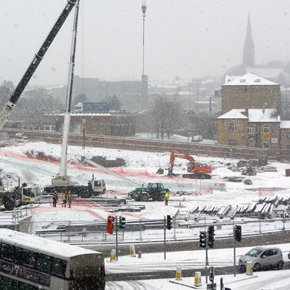
Hazards to look out for on a construction site during winter
As we all know, construction sites have never been the safest places on earth, although modern health and safety legislation tries its best to remedy that.
Construction will always remain a high-risk industry though and the winter season with its adverse weather conditions brings a whole different set of hazards to be aware of.
The Health and Safety Executive have produced a guidance document in which it says that several thousand construction workers are injured each year through simple slip and trip accidents with roughly 1000 of these resulting in fractures. The booklet goes on to document case studies of slip and trip incidents and suggest things which can be done to avoid them in future, such as keeping sites clean and tidy, or marking kerb edges clearly.
Injury statistics fall but no room for complacency
HSE figures showed that for the year ending March 2013 there was an 11% fall in major injuries among construction workers compared to the previous year with 19,707 injuries like amputations, fractures and burns, against 22,094 previously. There were 148 fatalities for the 2012/2013 period, down from 171 previously. However the HSE also says that with the economy growing along with the expected rise in construction project numbers and the increase in employee numbers these figures may well go up again.
So what are the winter hazards?
Construction sites are among the most dangerous places you can think of at any time of year but winter is perhaps the most problematic particularly because we are never quite sure what the good old British weather is going to throw at us.
Temperatures can vary from mildly cold to freezing; winds can vary from a gentle breeze to a howling gale and the rain can be anything from a fine drizzle to lashing it down. All this can ensure a plethora of problems for construction workers and their supervisors, from making sure the correct clothing is worn to beefing up site safety in line with the weather conditions and ensuring all plant machinery and essential equipment is protected from the elements.
Cold hands and feet
This might seem the most minor of issues but it is a fact that when you are very cold your concentration levels can fall significantly. Working in very cold weather can lead to lower productivity but more importantly higher accident rates.
At the most basic level, cold hands and fingers can result in a reduction in manual dexterity as joints become stiffened and uncomfortable. When feet are too cold it can be possible to lose a certain amount of feeling; this is an obvious hazard for those working at height or on narrow walkways. It seems silly to point it out but the obvious solution of wearing appropriate – and warm – gloves and footwear will go a long way towards reducing winter accident statistics.
And don’t forget the head. It has always been believed that we lose around 40-45% of our body heat through the head although various medical experts have diluted this myth over the years. However, the benefits of wearing warm headgear including for those who are required to wear a hard hat, are obvious.
Slippery when wet
Not just a standard safety sign, this refers to the likely condition of the ground underfoot when it is raining, snowing or icy. As we said earlier, slips and trips are a major hazard on construction sites at the best of times.
Throw in the worst of the winter weather and the risk is doubled. It goes without saying then that correct footwear with properly grippy soles should be worn at all times to give protection against the possibility of slipping on wet or icy surfaces. Site supervisors have a responsibility to make sure that all pathways and walkways are properly salted and/or cleared of ice, snow and any other obstructions.
Very cold and wet weather can cause problems in other areas too. Metal scaffolding may be difficult to keep a grip on in wet conditions whilst wooden walkways at height may be dangerously slippery. Extra care must be taken to keep these areas reasonably dry if possible.
Another hazard that, thankfully, appears only in the coldest of winters is something you may not even notice but certainly will if one falls on your head! And that is – icicles. It is probably a good idea to have a quick check before work begins and if any icicles are spotted carefully remove them if possible. If it isn’t possible to remove them then the area underneath the overhang should be cordoned off for safety.
Beware of the heat
Construction sites have always carried the risk of fire and according to the Fire Safety Advice Centre there are approximately 11 construction site fires every day. This is due to the variety of flammable materials and equipment used on site and the Construction (Design and Management) Regulations 2007 clearly set out instructions for dealing with fire risks and incidents.
During winter months the risk can come from portable heaters used in cabins and other enclosed spaces but also from heating equipment or dehumidifiers used to dry out flooded or damp areas.
Any heating equipment installed into an enclosed space should always be placed on fire-resistant surfaces and, in the case of gas heaters, must be used only where there is adequate ventilation. And of course, all equipment should carry the correct CE marking to certify that the equipment is compliant with EU safety and environmental regulations.
It may be tempting for individual workers, particularly on small or private construction sites, to bring in their own heaters to try and save costs but this would be a mistake. It may save costs in the short term but if you consider the long term consequences of future litigation because of health and safety breaches or injury to personnel, not including losses incurred due to employee sickness, the risks simply aren’t worth it.
As always, adhering to standard health and safety rules and applying common sense will go a long way to minimising winter hazards on construction sites.
Latest news

29th April 2025
Senior pledges to ‘bee’ part of the solution with new biodiversity initiative
Senior Architectural Systems has installed its first on-site beehive, marking another step forward in its commitment to sustainability and biodiversity.
Posted in Articles, Building Industry News, Building Products & Structures, Building Services, Curtain Walling, Doors, Glass, Glazing, Innovations & New Products, news, Restoration & Refurbishment, Retrofit & Renovation, Sustainability & Energy Efficiency, Walls, Windows
29th April 2025
West Fraser range delivering key benefits for South-East carpentry company
An experienced carpenter and building site manager who has recently set up his own company is using high performance panel products from the West Fraser range.
Posted in Articles, Building Industry News, Building Products & Structures, Building Systems, Case Studies, Garden, Restoration & Refurbishment, Retrofit & Renovation, Sustainability & Energy Efficiency, Timber Buildings and Timber Products
29th April 2025
CPD Courses Available Online From Ecological Building Systems
Ecological Building Systems, a leading supplier of natural building products for sustainable construction, has revealed its comprehensive CPD programme for the year ahead.
Posted in Articles, Building Industry Events, Building Industry News, Building Products & Structures, Building Services, Continuing Professional Development (CPD's), Information Technology, Innovations & New Products, Insulation, Restoration & Refurbishment, Retrofit & Renovation, Seminars, Sustainability & Energy Efficiency, Training, Walls, Waste Management & Recycling
29th April 2025
WindowBASE launches new prospect databases at FIT Show
Visit WindowBASE at the FIT Show to see first-hand how it helps companies find new customers – the company is launching an easy-to-use, intuitive platform on Stand G16 at the NEC Birmingham from 29th April – 1st May.
Posted in Articles, Building Industry Events, Building Industry News, Building Products & Structures, Building Services, Doors, Exhibitions and Conferences, Glass, Glazing, Information Technology, Innovations & New Products, Posts, Publications, Research & Materials Testing, Restoration & Refurbishment, Retrofit & Renovation, Windows
 Sign up:
Sign up: